Travels with Grace: Italy Part 2
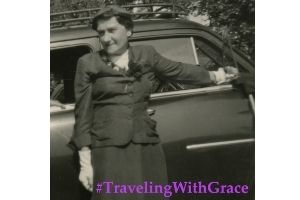
Welcome to this week’s segment of our 2019 #TravelTuesday series: Traveling with Grace. Today we continue through Italy and into Switzerland.
July 14, 1929
At 9:30 this morning we take private auto to Bellagio. It is a charming ride along the eastern shore of Lake Como passing many little villages, their houses in pastel shades with vine covered terraces and gay little flower gardens. As all over Italy the babies are very numerous and here, they look especially healthy and well cared for. Many ravines are carved thru the mountains and little streams flow down beneath old stone arches. The road is thickly lined with villas and hotels, their cool gardens luring the visitor from the hot sun of the open road. Some of the houses lie far below the road, crowding close to the water’s edge and then they are provided with little wharves.
At Bellagio we take a little motorboat and ride on the lake for about half an hour. We visit the Villa Melzi d’Eril and stroll about the beautiful gardens which are only open to the publish Sundays and Thursdays. However, the only other people we meet here are an English couple. The grounds are well kept, the trees of many species most luxuriant, the pines particularly giving out the most delightful spicy aroma. The air is heavy with the perfume of heliotrope and gardenia. Beneath clusters of trees are little seats built of rocks and rocky grottoes open in the sides of the mountain. There are holly bushes, and ivy encircles the tree trunks about which the roses also climb. Rustic bridges curve over ponds starred with red and white water lilies.

There is a pretty statue of Dante being led by Beatrice who points the way upward. A pretty little Moorish summer house invites one to rest at the water side and the villa itself, though not open to the public, presents a colorful façade in pure Italian style. From the boat we glimpse the Villa Giulia with its long avenue of cypresses. The views from the lake are more enchanting than those from the road. Flowering vines hang thickly over the walls, terrace after terrace of velvety green mount the slopes and melt into the timber line above. Huge rocks jut out into the water, one of which stands entirely isolated supporting two fir trees on its top. There are one or two little islands inhabited.
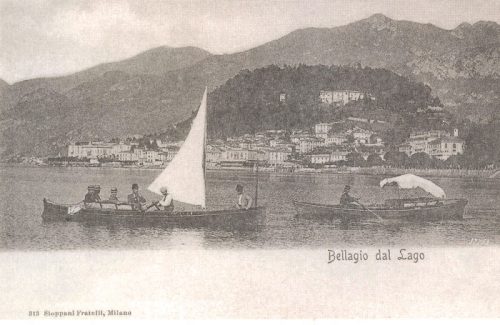
The picturesque fishing boats of the vicinity (Comacina) lend added charm and there are many tiny sail boats. Ladies sit beneath parasols in the row boats with a stalwart man at the oars. We take the auto up to the Villa Serbelloni where we take refreshments. It enjoys a high situation, but I do not like it as well as the Villa d’Este. On our return to Como we visit the handsome marble monument to A. Volta to which every country had contributed a piece of precious marble. Here are to be seen a collection of the instruments with which he worked. Tonight during the dancing I met Congressman Cohen from New York and Mme. Rosa Ponselle. The latter was so gracious and gave me her autograph.
July 15, 1929
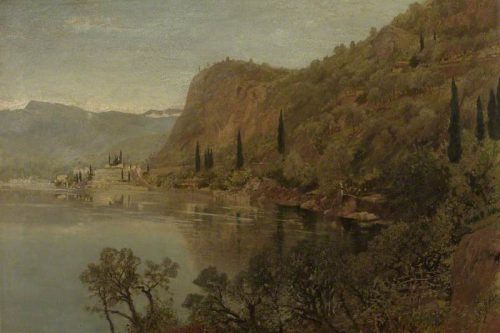
We leave the hotel at 9:45am in the same fine Fiat car we had yesterday and ride on the western shore of Lake Como as far as Tremezzo, passing through Moltrasio, Carate, Toriggia, Argegno, etc. There are exquisite villas and gardens everywhere. Each little village has a simple figure in bronze on a rough granite base.
This morning the women are busy at the pumps and troughs scrubbing away at their washing. Many women in this country carry huge vase-shaped baskets strapped to their backs piled high with brushwood or grass for their beast of burden. Men and women wear funny wooden sabots the toes sticking out and the heels slapping up and down. Many of the houses appear to have many windows (the shutters are always closed in the daytime) but on closer inspection half of them prove to be only simulated, that there is a groove which looks like a windowsill and the shutters are painted on. Once we see a woman appearing to open the shutters; she is also painted on. At Tremezzo we cross over a winding mountain road through some of the most beautiful country I have yet beheld, until the lake of Lugano comes into view. Then we clump up to Lange d’Intelvi where we enjoy a superb panorama over into Switzerland (Monte Bre) the lake branching off on either side below us. Then we descend by another spiral route to Menaggio on the Lake of Como where we lunch at the Grand Hotel. After lunch we follow the beautiful avenue shaded by plantain trees which connects Tremezzo and Cademabbia to the famous Villa Carlotta with its rich gardens and statuary. Returned to hotel at 4:30 p.m.
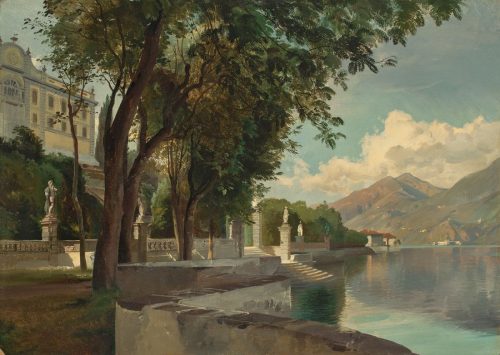
July 16, 1929

Started out on a long trip at 9:45 a.m. Every day the chauffeur puts fresh flowers in the car. We start by the way of Ghiasso, Stabbio, Arcisate and Varese, the first important town which is really very pretty. We see the fine war memorial, public gardens, business section, etc. Outside the town are some wonderful big hotels built on the heights and a little beyond the Lake of Varese a small but very attractive sheet of water. (From here we can look up and see Campo dei Fiori and Madre del Monte.) Soon we come to Lake Maggiore and skirt one side of it passing Ispra, Augera, Sesto Caleude, Olaggio, Arona, Meina, Lesa, Belginate, and Stusa where we stop for lunch at the Grand Hotel at des Iles Borronees. All along the shore we have been seeing the most exquisite villas and gardens ariot with color. They are usually planted on terraces and surrounded by cedar ledges or the most elaborate wrought iron grill work fences. The houses are of solid stone, windows and doorways frequently outlined in a mosaic pattern of colored stones or tiles with sometimes a broad frieze of the same around the top. On one house I notice a cute little weathervane, an iron silhouette of a woman watering a flower border, her watering can pointing toward the wind. Many of the houses of the poorer folk have one or two bird cages hanging before the doorway, the tiny feathered inhabitants adding their cheerful note to an already happy picture.
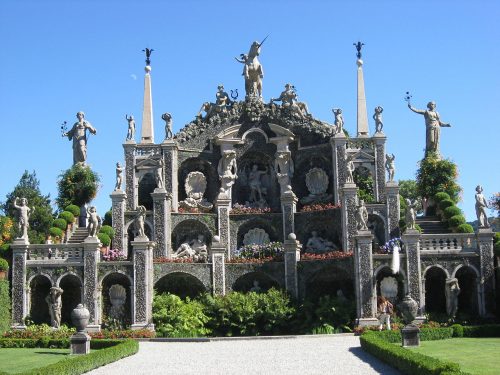
After lunch we hire a motorboat which takes us over to the Borromean Islands which are in plain view of the hotel. The Borromean family have been in possession of these islands for 250 years. There are three principal islands, Isola Madre, Isola Pescatori, and Isola Bella on which the family castle stands which is open to inspection and contains art treasures and mementos of Napoleon who stopped here at the time of the Battle of Marengo. The gardens are especially lovely and rich in variety of flora. They are terraced in pyramid shape and adorned with urns, statues, pergolas, etc., in effect like the fabled gardens of Babylon. We then resume our trip by auto which takes us further along the lake shore past Mattarone, Bavero, Ferriolo, Pallanza, Intra, Ghiffa, Oggebbia, Cannero, Cannolio (where we undergo the frontier formalities of the Swiss border) Brissago, Ancona, Locarno – a nice town with a peaceful leisurely atmosphere where we see the building, a fine edifice, in which the peach conference was held. Then we proceed to Lugano on the lake of that name which seems to be rather a large community chiefly of hotels and some very fine-looking ones at that. We cross a bridge over this lake and return over the mountains at sunset enjoying the beautiful panoramas bathed in the evening glow. Bells tinkle on the cows being led home from pasture. In the villages we see people taking their evening meal in the little gardens or courtyards, and young couple strolling arm in arm along the main street at this twilight hour seems to be the favorite time for promenading we return to the Villa d’Este at 8:30 p.m. Full moon on the lake.
July 17, 1929
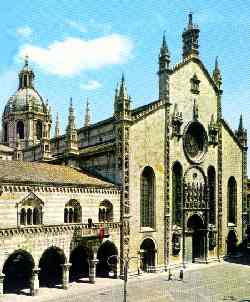
Today we took a carriage and rode to Como where we visited the fine 14th century cathedral, highly ornamental both inside and out. We looked at some of the shops and returned to the Villa d’Este for tea. It is a never-ending delight to sit here enjoying the lovely view and fine music.
July 19, 1929
The same car and chauffeur calls for us at 9 a.m. to take us from this beautiful haven of flowers, blue water, green hills, smiling villas and balmy breezes which waft toward us perfumes from the gardens and the soft chimes of the bells which ring forth every half hour from the neighboring church towers. We ride on the lake shore covering the same distance we traversed the other day as far as Menaggio and beyond that through Rezzonica, Gravedona, and on up to the head of the lake where it is more sparsely settled. At this end the Alps come into greater prominence and one begins to see snow on the furthest summits. The villages grow further apart, the flowery villas disappear and in their place is to be seen an occasional chalet of more rugged means to correspond with the changing character of the landscape. At Chiavenna we cross the border into Switzerland and begin the ascent over the Maloja Pass. The pine-clad slopes are brokern here and there by patches of emerald-green pasture and the Mera river bubbles merrily down its stony course beside the road. Waterfalls add a racy charm to the scene, one of particular beauty tumbling in six parallel cascades which later mingle to form three. Others are seen high up near the snowy summits and are suddenly lost to view and reappear after an interval, farther down. The tall cones of the firs rise row upon a row, like hundreds of battalions of soldiers marching erectly upward only stopping a little short of the rocky peaks. At Meloja and at Silvaplana are pretty little colonies of hotels and a chain of jade-green lakes begin which continue until we reach the lake of St. Moritz, in its setting of loft Engadine Alps studded liberally with glaciers and snow fields.
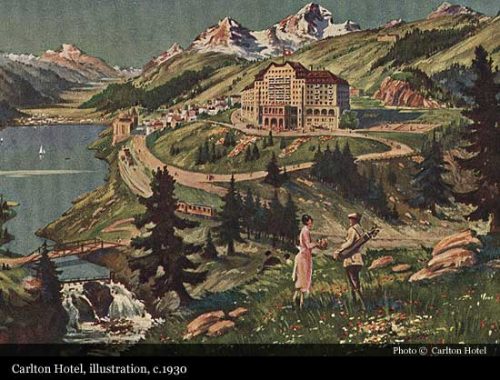
We stop at the hotel Carlton. The windows and balconies command choice views of the mountains, lake, and village. The Swiss clocks are well advertised here in the lifts, corridors and public rooms and when we look out of the windows, we see others across the way. No need to ever ask the time. On many of the smaller hotels are picturesque mural decorations, often taking the form of verses or proverbial sayings marked out in large block letters around the side walls. One house has the figure of a Pope in all his regalia painted on the front. Small as it is there are a number of craft on St. Moritz lake, row boats, motorboats, and I even note one little sail boat (it reminds me of a toy in a bathtub).
Thanks for reading “Traveling with Grace,” a series where we’re sharing (and annotating) posts from the travel diaries of Grace Amelia Hecht, native Baltimorean, b. 1897 and d. 1955. Next week we’ll continue through Switzerland. As mentioned in my introductory post transcription errors sometimes occur and I’ve made my best guesses where possible, denoted by [brackets]. – Rachel Kassman, marketing manager
